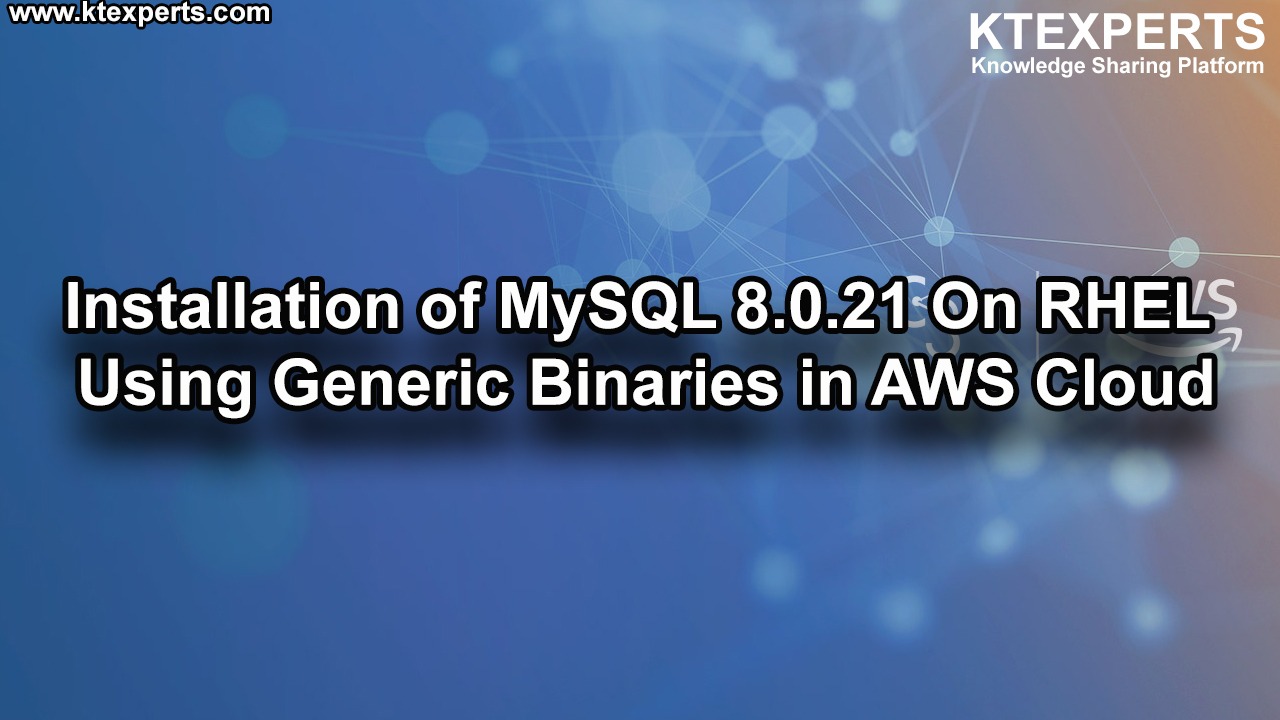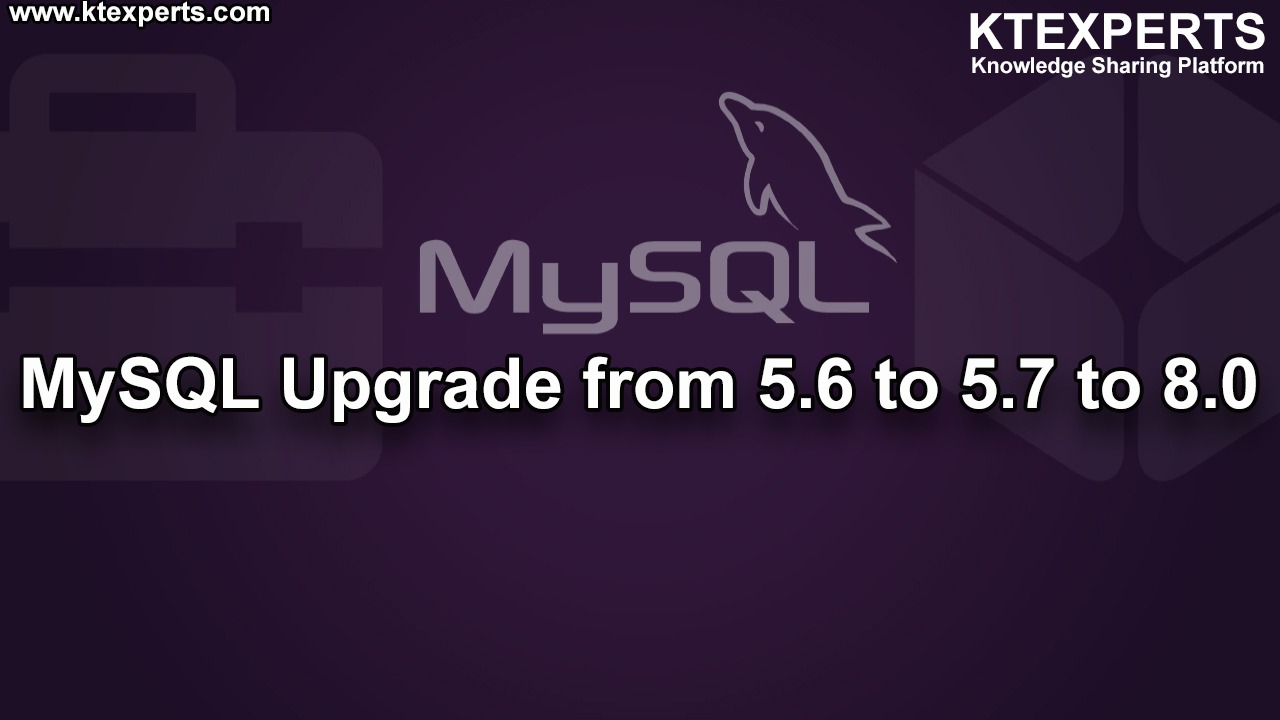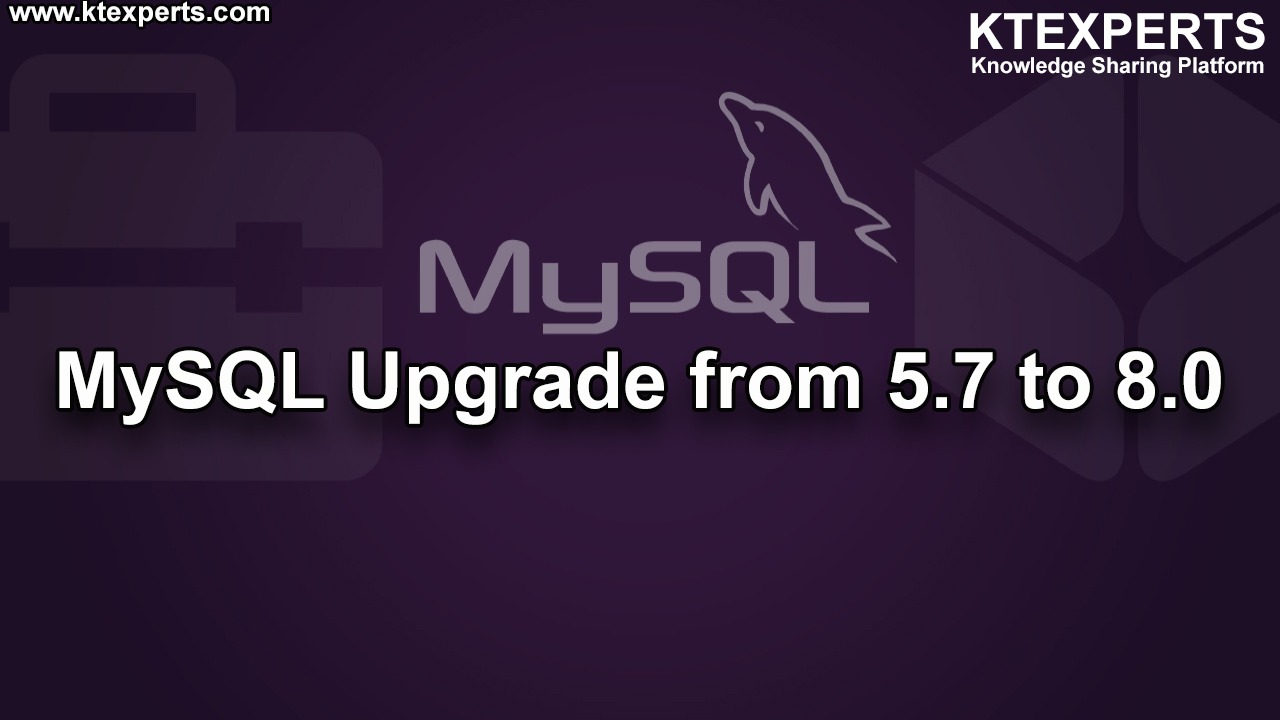Dear Readers,
In this article, we will see the following Install MySQL 5.6 On RHEL .

Steps to Follow :
- Logging to AWS Account
- Launch MySQL Server
- Connect to Linux EC2 Instance by Using Putty
- Switch to root user
- Install Server Updates
- Install wget package
- Disable MySQL Module
- Download 5.6 Binaries (rpm)
- Install 5.6 Binaries (rpm)
- Install MySQL Server 5.6
- Start the Service of MySQL
- Connect to MySQL Database
- Setting the root Password
- Connect to MySQL Database with Password
1. Logging to AWS Account
First, we need to AWS Console page by using below link.
https://aws.amazon.com/console/
Click on sign in to Console button.

Logging to aws account
Login using username & password and click on sign in.
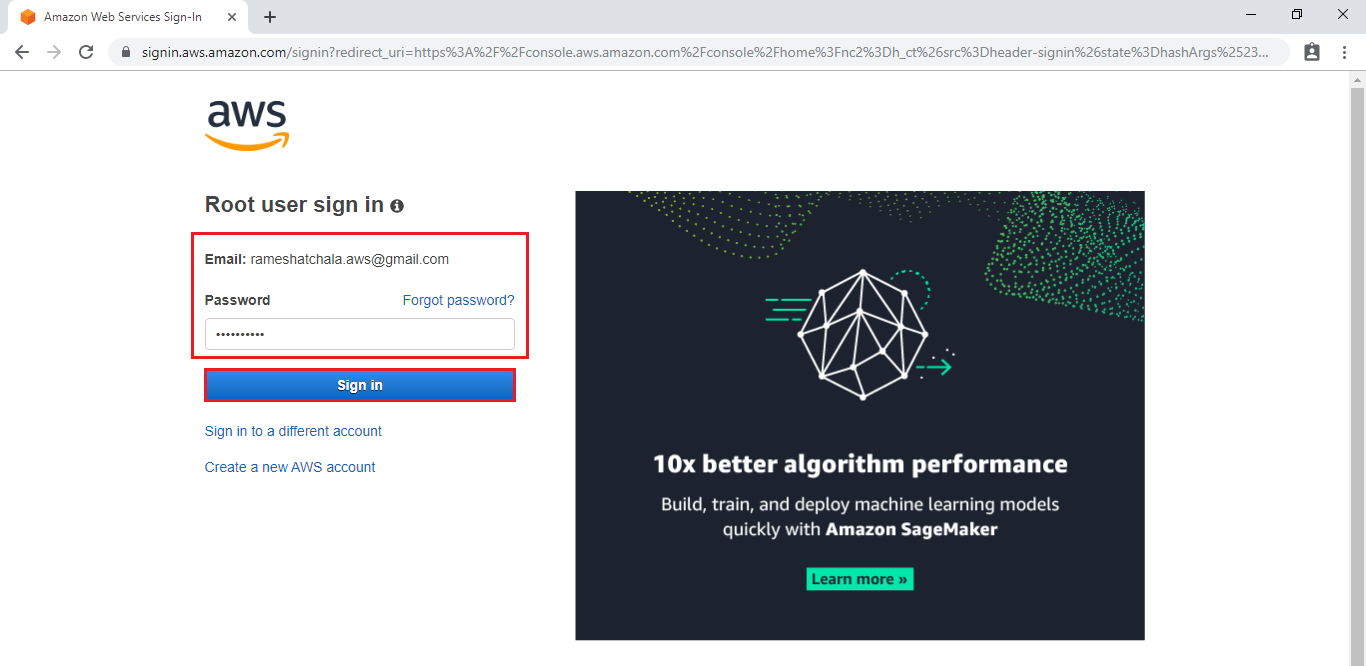
Enter to AWS Management Console
We can see the AWS Management Console Dashboard.
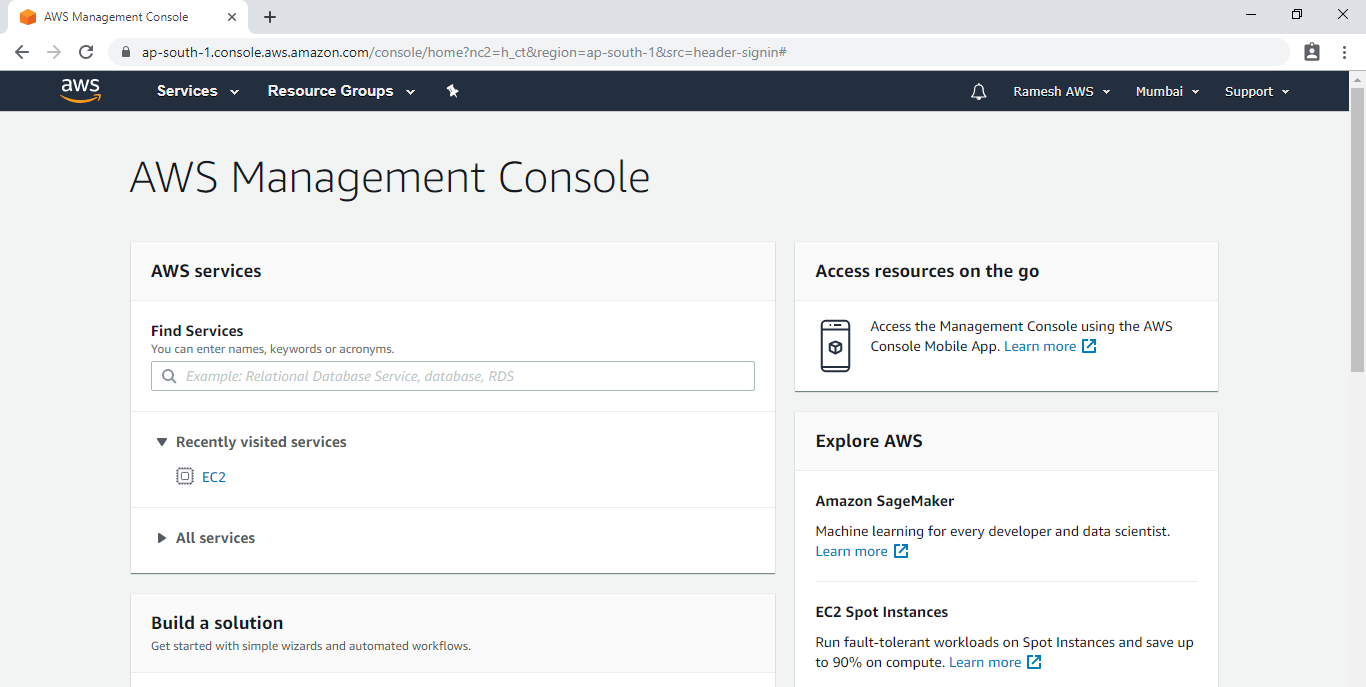
Go to Services, under the compute module click EC2 service to open.

2. Launch MySQL Server
Go to Services, under the compute module click EC2 service to open.

We can launch Windows Server by using below link.
We can see the windows server has been launched successfully.

3. Connect to Linux EC2 Instance Using Putty
We can connect putty by using below link.
Connect to MySQL Server Using Putty
|
1 2 3 |
login as: ec2-user Authenticating with public key "imported-openssh-key" [ec2-user@ip-172-31-41-179 ~]$ |
4. Switch to root user
|
1 2 |
[ec2-user@ip-172-31-41-7 ~]$ sudo su [root@ip-172-31-41-7 ec2-user]# |
5. Install Server updates
|
1 2 3 4 5 6 7 8 9 10 11 12 13 14 15 16 17 18 19 20 21 22 23 24 25 26 27 28 29 30 31 32 33 34 35 36 37 38 39 40 41 42 43 44 45 46 47 48 49 50 51 52 53 54 55 56 57 58 59 60 61 62 63 64 65 66 67 68 69 70 71 72 73 74 75 76 77 78 79 80 81 82 83 84 85 86 87 88 89 90 91 92 93 94 95 96 97 |
[root@ip-172-31-41-7 ec2-user]# yum update -y Red Hat Update Infrastructure 3 Client Configuration Server 8 14 kB/s | 3.5 kB 00:00 Red Hat Enterprise Linux 8 for x86_64 - AppStream from RHUI (RPMs) 39 MB/s | 25 MB 00:00 Red Hat Enterprise Linux 8 for x86_64 - BaseOS from RHUI (RPMs) 43 MB/s | 26 MB 00:00 Dependencies resolved. ============================================================================================================================================================================================================== Package Architecture Version Repository Size ============================================================================================================================================================================================================== Installing: kernel x86_64 4.18.0-240.8.1.el8_3 rhel-8-baseos-rhui-rpms 4.3 M kernel-core x86_64 4.18.0-240.8.1.el8_3 rhel-8-baseos-rhui-rpms 30 M kernel-modules x86_64 4.18.0-240.8.1.el8_3 rhel-8-baseos-rhui-rpms 26 M Upgrading: NetworkManager x86_64 1:1.26.0-12.el8_3 rhel-8-baseos-rhui-rpms 2.4 M NetworkManager-libnm x86_64 1:1.26.0-12.el8_3 rhel-8-baseos-rhui-rpms 1.8 M NetworkManager-team x86_64 1:1.26.0-12.el8_3 rhel-8-baseos-rhui-rpms 142 k NetworkManager-tui x86_64 1:1.26.0-12.el8_3 rhel-8-baseos-rhui-rpms 320 k cloud-init noarch 19.4-11.el8_3.1 rhel-8-appstream-rhui-rpms 945 k curl x86_64 7.61.1-14.el8_3.1 rhel-8-baseos-rhui-rpms 353 k freetype x86_64 2.9.1-4.el8_3.1 rhel-8-baseos-rhui-rpms 394 k gnutls x86_64 3.6.14-7.el8_3 rhel-8-baseos-rhui-rpms 1.0 M insights-client noarch 3.1.1-1.el8_3 rhel-8-appstream-rhui-rpms 1.0 M iptables-libs x86_64 1.8.4-15.el8_3.3 rhel-8-baseos-rhui-rpms 106 k kernel-tools x86_64 4.18.0-240.8.1.el8_3 rhel-8-baseos-rhui-rpms 4.5 M kernel-tools-libs x86_64 4.18.0-240.8.1.el8_3 rhel-8-baseos-rhui-rpms 4.3 M kexec-tools x86_64 2.0.20-34.el8_3.1 rhel-8-baseos-rhui-rpms 496 k libcurl x86_64 7.61.1-14.el8_3.1 rhel-8-baseos-rhui-rpms 299 k microcode_ctl x86_64 4:20200609-2.20201112.1.el8_3 rhel-8-baseos-rhui-rpms 4.6 M openssl x86_64 1:1.1.1g-12.el8_3 rhel-8-baseos-rhui-rpms 707 k openssl-libs x86_64 1:1.1.1g-12.el8_3 rhel-8-baseos-rhui-rpms 1.5 M python3-perf x86_64 4.18.0-240.8.1.el8_3 rhel-8-baseos-rhui-rpms 4.4 M qemu-guest-agent x86_64 15:4.2.0-34.module+el8.3.0+8829+e7a0a3ea.1 rhel-8-appstream-rhui-rpms 228 k systemd x86_64 239-41.el8_3.1 rhel-8-baseos-rhui-rpms 3.5 M systemd-libs x86_64 239-41.el8_3.1 rhel-8-baseos-rhui-rpms 1.1 M systemd-pam x86_64 239-41.el8_3.1 rhel-8-baseos-rhui-rpms 456 k systemd-udev x86_64 239-41.el8_3.1 rhel-8-baseos-rhui-rpms 1.3 M tuned noarch 2.14.0-3.el8_3.1 rhel-8-baseos-rhui-rpms 292 k Installing dependencies: linux-firmware noarch 20200619-101.git3890db36.el8_3 rhel-8-baseos-rhui-rpms 101 M Transaction Summary ============================================================================================================================================================================================================== Install 4 Packages Upgrade 24 Packages Total download size: 198 M Downloading Packages: (1/28): kernel-4.18.0-240.8.1.el8_3.x86_64.rpm 15 MB/s | 4.3 MB 00:00 (2/28): kernel-core-4.18.0-240.8.1.el8_3.x86_64.rpm 33 MB/s | 30 MB 00:00 (3/28): kernel-modules-4.18.0-240.8.1.el8_3.x86_64.rpm 22 MB/s | 26 MB 00:01 (4/28): cloud-init-19.4-11.el8_3.1.noarch.rpm 3.6 MB/s | 945 kB 00:00 (5/28): qemu-guest-agent-4.2.0-34.module+el8.3.0+8829+e7a0a3ea.1.x86_64.rpm 1.9 MB/s | 228 kB 00:00 (6/28): insights-client-3.1.1-1.el8_3.noarch.rpm 6.8 MB/s | 1.0 MB 00:00 (7/28): NetworkManager-team-1.26.0-12.el8_3.x86_64.rpm 1.3 MB/s | 142 kB 00:00 (8/28): freetype-2.9.1-4.el8_3.1.x86_64.rpm 3.1 MB/s | 394 kB 00:00 -------------------------------------------------------------------------------------------------------------------------------------------------------------------------------------------------------------- Total 64 MB/s | 198 MB 00:03 Running transaction check Transaction check succeeded. Running transaction test Transaction test succeeded. Running transaction Preparing : 1/1 Running scriptlet: systemd-libs-239-41.el8_3.1.x86_64 1/1 Upgrading : systemd-libs-239-41.el8_3.1.x86_64 1/52 Running scriptlet: systemd-libs-239-41.el8_3.1.x86_64 1/52 Upgrading : gnutls-3.6.14-7.el8_3.x86_64 2/52 Upgrading : openssl-libs-1:1.1.1g-12.el8_3.x86_64 3/52 Running scriptlet: openssl-libs-1:1.1.1g-12.el8_3.x86_64 3/52 Upgrading : libcurl-7.61.1-14.el8_3.1.x86_64 4/52 Upgrading : NetworkManager-libnm-1:1.26.0-12.el8_3.x86_64 5/52 Running scriptlet: NetworkManager-libnm-1:1.26.0-12.el8_3.x86_64 5/52 Upgrading : iptables-libs-1.8.4-15.el8_3.3.x86_64 6/52 Running scriptlet: systemd-239-41.el8_3.1.x86_64 7/52 Upgrading : systemd-239-41.el8_3.1.x86_64 7/52 Running scriptlet: systemd-239-41.el8_3.1.x86_64 7/52 Upgrading : systemd-pam-239-41.el8_3.1.x86_64 8/52 Verifying : kernel-modules-4.18.0-240.8.1.el8_3.x86_64 1/52 Verifying : kernel-core-4.18.0-240.8.1.el8_3.x86_64 2/52 Verifying : kernel-4.18.0-240.8.1.el8_3.x86_64 3/52 Verifying : linux-firmware-20200619-101.git3890db36.el8_3.noarch 4/52 Verifying : cloud-init-19.4-11.el8_3.1.noarch 5/52 Verifying : cloud-init-19.4-11.el8.noarch 6/52 Verifying : insights-client-3.1.1-1.el8_3.noarch 7/52 Verifying : insights-client-3.1.0-3.el8.noarch 8/52 Upgraded: NetworkManager-1:1.26.0-12.el8_3.x86_64 NetworkManager-libnm-1:1.26.0-12.el8_3.x86_64 NetworkManager-team-1:1.26.0-12.el8_3.x86_64 NetworkManager-tui-1:1.26.0-12.el8_3.x86_64 cloud-init-19.4-11.el8_3.1.noarch curl-7.61.1-14.el8_3.1.x86_64 freetype-2.9.1-4.el8_3.1.x86_64 gnutls-3.6.14-7.el8_3.x86_64 insights-client-3.1.1-1.el8_3.noarch iptables-libs-1.8.4-15.el8_3.3.x86_64 kernel-tools-4.18.0-240.8.1.el8_3.x86_64 kernel-tools-libs-4.18.0-240.8.1.el8_3.x86_64 kexec-tools-2.0.20-34.el8_3.1.x86_64 libcurl-7.61.1-14.el8_3.1.x86_64 microcode_ctl-4:20200609-2.20201112.1.el8_3.x86_64 openssl-1:1.1.1g-12.el8_3.x86_64 openssl-libs-1:1.1.1g-12.el8_3.x86_64 python3-perf-4.18.0-240.8.1.el8_3.x86_64 qemu-guest-agent-15:4.2.0-34.module+el8.3.0+8829+e7a0a3ea.1.x86_64 systemd-239-41.el8_3.1.x86_64 systemd-libs-239-41.el8_3.1.x86_64 systemd-pam-239-41.el8_3.1.x86_64 systemd-udev-239-41.el8_3.1.x86_64 tuned-2.14.0-3.el8_3.1.noarch Installed: kernel-4.18.0-240.8.1.el8_3.x86_64 kernel-core-4.18.0-240.8.1.el8_3.x86_64 kernel-modules-4.18.0-240.8.1.el8_3.x86_64 linux-firmware-20200619-101.git3890db36.el8_3.noarch Complete! |
6. Install wget package
|
1 2 3 4 5 6 7 8 9 10 11 12 13 14 15 16 17 18 19 20 21 22 23 24 25 26 27 28 29 30 31 32 33 |
[root@ip-172-31-41-7 ec2-user]# yum install wget -y Last metadata expiration check: 0:04:39 ago on Mon 28 Dec 2020 08:06:57 AM UTC. Dependencies resolved. ============================================================================================================================================================================================================== Package Architecture Version Repository Size ============================================================================================================================================================================================================== Installing: wget x86_64 1.19.5-10.el8 rhel-8-appstream-rhui-rpms 734 k Transaction Summary ============================================================================================================================================================================================================== Install 1 Package Total download size: 734 k Installed size: 2.8 M Downloading Packages: wget-1.19.5-10.el8.x86_64.rpm 5.0 MB/s | 734 kB 00:00 -------------------------------------------------------------------------------------------------------------------------------------------------------------------------------------------------------------- Total 3.9 MB/s | 734 kB 00:00 Running transaction check Transaction check succeeded. Running transaction test Transaction test succeeded. Running transaction Preparing : 1/1 Installing : wget-1.19.5-10.el8.x86_64 1/1 Running scriptlet: wget-1.19.5-10.el8.x86_64 1/1 Verifying : wget-1.19.5-10.el8.x86_64 1/1 Installed: wget-1.19.5-10.el8.x86_64 Complete! |
7. Disable Module
|
1 2 3 4 5 6 7 8 9 10 11 12 13 14 15 16 |
[root@ip-172-31-41-7 ec2-user]# yum module disable mysql MySQL Connectors Community 713 kB/s | 94 kB 00:00 MySQL Tools Community 3.3 MB/s | 553 kB 00:00 MySQL 5.6 Community Server 10 MB/s | 2.0 MB 00:00 Dependencies resolved. ============================================================================================================================================================================================================== Package Architecture Version Repository Size ============================================================================================================================================================================================================== Disabling modules: mysql Transaction Summary ============================================================================================================================================================================================================== Is this ok [y/N]: y Complete! |
8. Download 5.6 Binaries (rpm)
Go to mysql official website by using below link.
Select 5.6 binary (rpm) and copy the link address by giving right click.

Go to server terminal and download the rpm
|
1 2 3 4 5 6 7 8 9 10 11 12 13 14 15 |
[root@ip-172-31-41-7 ec2-user]# wget http://repo.mysql.com/mysql-community-release-el7-5.noarch.rpm --2020-12-28 08:16:31-- http://repo.mysql.com/mysql-community-release-el7-5.noarch.rpm Resolving repo.mysql.com (repo.mysql.com)... 184.26.84.248 Connecting to repo.mysql.com (repo.mysql.com)|184.26.84.248|:80... connected. HTTP request sent, awaiting response... 200 OK Length: 6140 (6.0K) [application/x-redhat-package-manager] Saving to: ‘mysql-community-release-el7-5.noarch.rpm’ mysql-community-release-el7-5.noarch.rpm 100%[=================================================================================================================>] 6.00K --.-KB/s in 0s 2020-12-28 08:16:31 (502 MB/s) - ‘mysql-community-release-el7-5.noarch.rpm’ saved [6140/6140] [root@ip-172-31-41-7 ec2-user]# ll total 8 -rw-r--r--. 1 root root 6140 Nov 12 2015 mysql-community-release-el7-5.noarch.rpm |
9. Install 5.6 Binaries (rpm)
|
1 2 3 4 5 |
[root@ip-172-31-41-7 ec2-user]# rpm -ivh mysql-community-release-el7-5.noarch.rpm Verifying... ################################# [100%] Preparing... ################################# [100%] Updating / installing... 1:mysql-community-release-el7-5 ################################# [100%] |
10. Install MySQL Server 5.6
|
1 2 3 4 5 6 7 8 9 10 11 12 13 14 15 16 17 18 19 20 21 22 23 24 25 26 27 28 29 30 31 32 33 34 35 36 37 38 39 40 41 42 43 44 45 46 47 48 49 50 51 52 53 54 55 56 57 58 59 60 61 62 63 64 65 66 67 68 69 70 71 72 73 74 75 76 77 78 79 80 81 82 83 84 85 86 87 88 |
[root@ip-172-31-41-7 ec2-user]# yum install mysql-community-server --nogpgcheck Last metadata expiration check: 0:00:36 ago on Mon 28 Dec 2020 08:18:00 AM UTC. Dependencies resolved. ============================================================================================================================================================================================================== Package Architecture Version Repository Size ============================================================================================================================================================================================================== Installing: mysql-community-server x86_64 5.6.50-2.el7 mysql56-community 67 M Installing dependencies: libaio x86_64 0.3.112-1.el8 rhel-8-baseos-rhui-rpms 33 k mysql-community-client x86_64 5.6.50-2.el7 mysql56-community 21 M mysql-community-common x86_64 5.6.50-2.el7 mysql56-community 287 k mysql-community-libs x86_64 5.6.50-2.el7 mysql56-community 2.2 M ncurses-compat-libs x86_64 6.1-7.20180224.el8 rhel-8-baseos-rhui-rpms 331 k perl-Carp noarch 1.42-396.el8 rhel-8-baseos-rhui-rpms 30 k perl-DBI x86_64 1.641-3.module+el8.3.0+6481+fbe55708 rhel-8-appstream-rhui-rpms 740 k perl-Data-Dumper x86_64 2.167-399.el8 rhel-8-baseos-rhui-rpms 58 k perl-Digest noarch 1.17-395.el8 rhel-8-appstream-rhui-rpms 27 k perl-Digest-MD5 x86_64 2.55-396.el8 rhel-8-appstream-rhui-rpms 37 k perl-Encode x86_64 4:2.97-3.el8 rhel-8-baseos-rhui-rpms 1.5 M perl-Errno x86_64 1.28-416.el8 rhel-8-baseos-rhui-rpms 76 k perl-Exporter noarch 5.72-396.el8 rhel-8-baseos-rhui-rpms 34 k perl-File-Path noarch 2.15-2.el8 rhel-8-baseos-rhui-rpms 38 k perl-File-Temp noarch 0.230.600-1.el8 rhel-8-baseos-rhui-rpms 63 k perl-Getopt-Long noarch 1:2.50-4.el8 rhel-8-baseos-rhui-rpms 63 k perl-HTTP-Tiny noarch 0.074-1.el8 rhel-8-baseos-rhui-rpms 58 k perl-IO x86_64 1.38-416.el8 rhel-8-baseos-rhui-rpms 141 k Transaction Summary ============================================================================================================================================================================================================== Install 50 Packages Total download size: 103 M Installed size: 401 M Is this ok [y/N]: y Downloading Packages: (1/50): mysql-community-common-5.6.50-2.el7.x86_64.rpm 2.5 MB/s | 287 kB 00:00 (2/50): mysql-community-libs-5.6.50-2.el7.x86_64.rpm 13 MB/s | 2.2 MB 00:00 (3/50): perl-Mozilla-CA-20160104-7.module+el8.3.0+6498+9eecfe51.noarch.rpm 138 kB/s | 15 kB 00:00 (4/50): perl-URI-1.73-3.el8.noarch.rpm 1.1 MB/s | 116 kB 00:00 (5/50): perl-Net-SSLeay-1.88-1.module+el8.3.0+6446+594cad75.x86_64.rpm 3.4 MB/s | 379 kB 00:00 (6/50): mysql-community-client-5.6.50-2.el7.x86_64.rpm 33 MB/s | 21 MB 00:00 (7/50): perl-Digest-1.17-395.el8.noarch.rpm 210 kB/s | 27 kB 00:00 (8/50): perl-DBI-1.641-3.module+el8.3.0+6481+fbe55708.x86_64.rpm 6.1 MB/s | 740 kB 00:00 -------------------------------------------------------------------------------------------------------------------------------------------------------------------------------------------------------------- Total 41 MB/s | 103 MB 00:02 Running transaction check Transaction check succeeded. Running transaction test Transaction test succeeded. Running transaction Preparing : 1/1 Installing : perl-libs-4:5.26.3-416.el8.x86_64 1/50 Installing : perl-Exporter-5.72-396.el8.noarch 2/50 Installing : perl-Carp-1.42-396.el8.noarch 3/50 Installing : perl-Scalar-List-Utils-3:1.49-2.el8.x86_64 4/50 Installing : perl-parent-1:0.237-1.el8.noarch 5/50 Installing : perl-Text-ParseWords-3.30-395.el8.noarch 6/50 Installing : mysql-community-common-5.6.50-2.el7.x86_64 7/50 Installing : mysql-community-libs-5.6.50-2.el7.x86_64 8/50 Running scriptlet: mysql-community-libs-5.6.50-2.el7.x86_64 8/50 Verifying : mysql-community-client-5.6.50-2.el7.x86_64 1/50 Verifying : mysql-community-common-5.6.50-2.el7.x86_64 2/50 Verifying : mysql-community-libs-5.6.50-2.el7.x86_64 3/50 Verifying : mysql-community-server-5.6.50-2.el7.x86_64 4/50 Verifying : perl-Mozilla-CA-20160104-7.module+el8.3.0+6498+9eecfe51.noarch 5/50 Verifying : perl-URI-1.73-3.el8.noarch 6/50 Verifying : perl-Net-SSLeay-1.88-1.module+el8.3.0+6446+594cad75.x86_64 7/50 Verifying : perl-Digest-1.17-395.el8.noarch 8/50 Installed: libaio-0.3.112-1.el8.x86_64 mysql-community-client-5.6.50-2.el7.x86_64 mysql-community-common-5.6.50-2.el7.x86_64 mysql-community-libs-5.6.50-2.el7.x86_64 mysql-community-server-5.6.50-2.el7.x86_64 ncurses-compat-libs-6.1-7.20180224.el8.x86_64 perl-Carp-1.42-396.el8.noarch perl-DBI-1.641-3.module+el8.3.0+6481+fbe55708.x86_64 perl-Data-Dumper-2.167-399.el8.x86_64 perl-Digest-1.17-395.el8.noarch perl-Digest-MD5-2.55-396.el8.x86_64 perl-Encode-4:2.97-3.el8.x86_64 perl-Errno-1.28-416.el8.x86_64 perl-Exporter-5.72-396.el8.noarch perl-File-Path-2.15-2.el8.noarch perl-File-Temp-0.230.600-1.el8.noarch perl-Getopt-Long-1:2.50-4.el8.noarch perl-HTTP-Tiny-0.074-1.el8.noarch perl-IO-1.38-416.el8.x86_64 perl-IO-Socket-IP-0.39-5.el8.noarch perl-IO-Socket-SSL-2.066-4.module+el8.3.0+6446+594cad75.noarch perl-MIME-Base64-3.15-396.el8.x86_64 perl-Math-BigInt-1:1.9998.11-7.el8.noarch perl-Math-Complex-1.59-416.el8.noarch perl-Mozilla-CA-20160104-7.module+el8.3.0+6498+9eecfe51.noarch perl-Net-SSLeay-1.88-1.module+el8.3.0+6446+594cad75.x86_64 perl-PathTools-3.74-1.el8.x86_64 perl-Pod-Escapes-1:1.07-395.el8.noarch perl-Pod-Perldoc-3.28-396.el8.noarch perl-Pod-Simple-1:3.35-395.el8.noarch perl-Pod-Usage-4:1.69-395.el8.noarch perl-Scalar-List-Utils-3:1.49-2.el8.x86_64 perl-Socket-4:2.027-3.el8.x86_64 perl-Storable-1:3.11-3.el8.x86_64 perl-Term-ANSIColor-4.06-396.el8.noarch perl-Term-Cap-1.17-395.el8.noarch perl-Text-ParseWords-3.30-395.el8.noarch perl-Text-Tabs+Wrap-2013.0523-395.el8.noarch perl-Time-Local-1:1.280-1.el8.noarch perl-URI-1.73-3.el8.noarch perl-Unicode-Normalize-1.25-396.el8.x86_64 perl-constant-1.33-396.el8.noarch perl-interpreter-4:5.26.3-416.el8.x86_64 perl-libnet-3.11-3.el8.noarch perl-libs-4:5.26.3-416.el8.x86_64 perl-macros-4:5.26.3-416.el8.x86_64 perl-parent-1:0.237-1.el8.noarch perl-podlators-4.11-1.el8.noarch perl-threads-1:2.21-2.el8.x86_64 perl-threads-shared-1.58-2.el8.x86_64 Complete! |
11. Check Version of MySQL
|
1 2 |
[root@ip-172-31-41-7 ec2-user]# mysql -V mysql Ver 14.14 Distrib 5.6.50, for Linux (x86_64) using EditLine wrapper |
12. Start the Service of MySQL
|
1 2 |
[root@ip-172-31-41-7 ec2-user]# service mysqld start Redirecting to /bin/systemctl start mysqld.service |
13. Check the Status of MySQL
|
1 2 3 4 5 6 7 8 9 10 11 12 13 14 15 |
[root@ip-172-31-41-7 ec2-user]# service mysqld start Redirecting to /bin/systemctl start mysqld.service [root@ip-172-31-41-7 ec2-user]# service mysqld status Redirecting to /bin/systemctl status mysqld.service ● mysqld.service - MySQL Community Server Loaded: loaded (/usr/lib/systemd/system/mysqld.service; enabled; vendor preset: disabled) Active: active (running) since Mon 2020-12-28 08:22:56 UTC; 4s ago Process: 58906 ExecStartPost=/usr/bin/mysql-systemd-start post (code=exited, status=0/SUCCESS) Process: 58846 ExecStartPre=/usr/bin/mysql-systemd-start pre (code=exited, status=0/SUCCESS) Main PID: 58905 (mysqld_safe) Tasks: 23 (limit: 4836) Memory: 493.3M CGroup: /system.slice/mysqld.service ├─58905 /bin/sh /usr/bin/mysqld_safe --basedir=/usr └─59080 /usr/sbin/mysqld --basedir=/usr --datadir=/var/lib/mysql --plugin-dir=/usr/lib64/mysql/plugin --log-error=/var/log/mysqld.log --pid-file=/var/run/mysqld/mysqld.pid --socket=/var/lib/mysq> |
14. Connect to MySQL Database
|
1 2 3 4 5 6 7 8 9 10 11 12 13 14 |
[root@ip-172-31-41-7 ec2-user]# mysql -u root Welcome to the MySQL monitor. Commands end with ; or \g. Your MySQL connection id is 2 Server version: 5.6.50 MySQL Community Server (GPL) Copyright (c) 2000, 2020, Oracle and/or its affiliates. All rights reserved. Oracle is a registered trademark of Oracle Corporation and/or its affiliates. Other names may be trademarks of their respective owners. Type 'help;' or '\h' for help. Type '\c' to clear the current input statement. mysql> |
15. Check the version of MySQL
|
1 2 3 4 5 6 7 |
mysql> select @@version; +-----------+ | @@version | +-----------+ | 5.6.50 | +-----------+ 1 row in set (0.01 sec) |
16. Setting the root Password
This command enables you to improve the security of your MySQL installation in the following ways:
👉 You can set a password for root accounts.
👉 You can remove root accounts that are accessible from outside the local host.
👉 You can remove anonymous-user accounts.
👉 You can remove the test database, which by default can be accessed by anonymous users.
|
1 2 3 4 5 6 7 8 9 10 11 12 13 14 15 16 17 18 19 20 21 22 23 24 25 26 27 28 29 30 31 32 33 34 35 36 37 38 39 40 41 42 43 44 45 46 47 48 49 50 51 52 53 54 55 56 57 |
[root@ip-172-31-41-7 ec2-user]# mysql_secure_installation NOTE: RUNNING ALL PARTS OF THIS SCRIPT IS RECOMMENDED FOR ALL MySQL SERVERS IN PRODUCTION USE! PLEASE READ EACH STEP CAREFULLY! In order to log into MySQL to secure it, we'll need the current password for the root user. If you've just installed MySQL, and you haven't set the root password yet, the password will be blank, so you should just press enter here. Enter current password for root (enter for none): OK, successfully used password, moving on... Setting the root password ensures that nobody can log into the MySQL root user without the proper authorisation. Set root password? [Y/n] y New password: Re-enter new password: Password updated successfully! Reloading privilege tables.. ... Success! By default, a MySQL installation has an anonymous user, allowing anyone to log into MySQL without having to have a user account created for them. This is intended only for testing, and to make the installation go a bit smoother. You should remove them before moving into a production environment. Remove anonymous users? [Y/n] y ... Success! Normally, root should only be allowed to connect from 'localhost'. This ensures that someone cannot guess at the root password from the network. Disallow root login remotely? [Y/n] y ... Success! By default, MySQL comes with a database named 'test' that anyone can access. This is also intended only for testing, and should be removed before moving into a production environment. Remove test database and access to it? [Y/n] y ... skipping. Reloading the privilege tables will ensure that all changes made so far will take effect immediately. Reload privilege tables now? [Y/n] y ... skipping. All done! If you've completed all of the above steps, your MySQL installation should now be secure. Thanks for using MySQL! Cleaning up... |
17. Connect to MySQL Database
|
1 2 3 4 5 6 7 8 9 10 11 12 13 14 15 16 17 18 19 20 21 |
[root@ip-172-31-41-7 ec2-user]# mysql -u root -p Enter password: Welcome to the MySQL monitor. Commands end with ; or \g. Your MySQL connection id is 15 Server version: 5.6.50 MySQL Community Server (GPL) Copyright (c) 2000, 2020, Oracle and/or its affiliates. All rights reserved. Oracle is a registered trademark of Oracle Corporation and/or its affiliates. Other names may be trademarks of their respective owners. Type 'help;' or '\h' for help. Type '\c' to clear the current input statement. mysql>select @@version; +-----------+ | @@version | +-----------+ | 5.6.50 | +-----------+ 1 row in set (0.01 sec) |
Thank you for giving your valuable time to read the above information.
Follow us on
Website : www.ktexperts.com
Facebook Page : KTexperts
Linkedin Page : KT EXPERTS
Follow Me
Ramesh’s Linkedin : Ramesh Atchala


